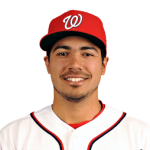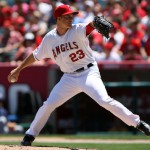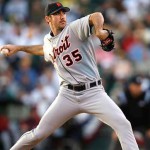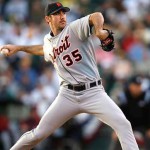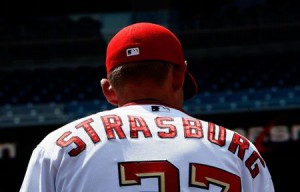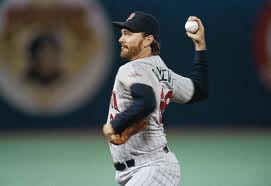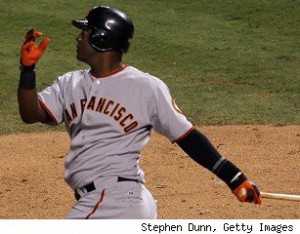With the first couple of Spring Training games in the books, its fitting that Tom Boswell did a Monday morning chat on 2/25/13.
Here’s how I’d have responded to the Baseball-specific questions he took. As always, questions are edited for clarity and I write here before reading his response so as not to “color” my answer.
Q: Given that the Nats know almost every player making the roster out of Spring Training, do the players/coaches approach the 6 weeks differently?
A: Good question; I was taking with someone about this exact topic this weekend. The 25-man roster is essentially already solidifed; perhaps the only question remaining is whether or not Henry Rodriguez makes it onto the team or does the team carry a second lefty reliever (Bill Bray?). So I think the answer has to do with looking more at the AAA talent, looking at minor league FA signings like Micah Owings and Chris Snyder to see if they’re going to be better options than the guys we already had slated at AAA. And the coaching staff gets to look at up-and-coming guys like Anthony Rendon, Zach Walters, and the like. Boswell reiterates what I said here, naming other ML signings of interest like Chris Young, but also says that this ST has a lot of “wasted time.”
Q: I’ve spent the offseason reading Ball Four to help get my baseball fix. Do you have a sense about how different things are now?
A: It has been a while since I read Jim Bouton‘s seminal baseball book Ball Four. But the season he chronicles (1969) happened before a number of rather important moments in Baseball history. Expansion, divisional play, the Designated Hitter, the aftermath of the Curtis Flood and Andy Messersmith decisions (aka, Free Agency) and of course the massive increase of money in the game (both from a revenue stand point and from a player salary stand point). One thing that seems certain to have changed; players can now earn enough in a season to be set financially for life. And, the players union’s power is now such that players have the upper hand in a lot of negotiations with the league and the owners when it comes to labor unions. Boswell notes that managers, coaches and GMs are far “smarter” now than they were in the Bouton era.
Q: How the Nats will do at the gate this year?
A: The season ticket base is back to where it was in 2005 apparently, broaching 20,000 season tickets. The team averaged 29,269 fans last year. Clearly the attendance seems set to rise significantly. I think they’ll average 35,000 a night if they continue to be a first-place club. Boswell agrees, noting that the team also has a couple of very marketable stars to help with attendance.
Q: Other than obvious injuries, are there any things that can happen in the first quarter of the year that you would find to be troubling?
A: I’d be troubled if Danny Espinosa started off slow. I’d also be concerned if we saw significant regression out of our WBC participants Gio Gonzalez and Ross Detwiler, confirming my fears. But the most important factor may be the performance of Dan Haren: is he the 2012 Haren or the 2009 Haren? If he approaches 2009 version, this team may be set for the season. Boswell notes they have a tough early schedule, that winning 98 games is tough, and that we should be patient.
Q: Gio Gonzalez; did he or didn’t he?
A: I think the prevailing opinion in the sport now seems to be that he did NOT take or receive PEDs from the Miami clinic, and that he was an unfortunate bystander. His passing a surprise PED test given two days after the scandal seems to have also bolstered his case. Boswell agrees.
Q: Are the Nats a 98 win team again, or was last year a fluke?
A: Barring a significant injury in the rotation, I think the Nats are easily a 98-win team and perhaps better in 2013. Statistical WAR “proof” offered in this space back in January, and that was before the LaRoche re-signing and the Soriano pickup, both of which marginally should improve the team a few wins. Most national pundits that I’ve read think the same thing, that this team could win 103 games. The various estimator stats out there (Zips, Pecota, etc) the team much closer to 90 wins, but those predictors are by and large incredibly conservative. Boswell also says it comes down to health of the rotation.
Q: How would you rate the Nats starting rotation, spot by spot, compared to the rest of the Major Leagues?
A: Spot by Spot, its hard not to think that each of our guys are each at least in the top 5 by position in the league. Drawing from my Rotational Rankings post from January 7th, 2013, I’d say that:
- Strasburg is clearly among the best arms in the game (in the discussion along with Verlander, Kershaw, and Hernandez). He’s not as accomplished as this group of course, but his talent is unquestionable.
- Gonzalez matches up as a top 5 number two starter (other candidates: Greinke, Hamels, Lincecum or Cain, depending on who you think SF’s “ace” is).
- Zimmermann is traditionally underrated but is at least a top 5 number three starter (along with Scherzer, Johnson/Morrow, Bumgarner, Lee and Moore).
- Haren on potential could be the best number four starter in the game, though Buehrle, Miley, and Lynn could also fit in here.
- Detwiler is often mentioned as being the best number five starter out there, and its hard to find competitors (best options: Zito, Romero, Garcia, and whoever Oakland and St. Louis settle upon for their #5 starters).
Boswell seems worried that these five guys can handle the workload all year, only really trusting Gonzalez in terms of repeatability.
Q: What future do you see for Anthony Rendon, and when will he debut in the majors?
A: I have been of the belief that Zimmerman should move to 1B for Rendon at some point. But with LaRoche signed for two years, that won’t happen for a while (2 years, perhaps 3 if we pick up his 2015 option). So now i’m starting to come around to the the possibility of Rendon pushing someone else off their position. The most likely candidate seems to be Espinosa at 2B. Despite having Lombardozzi on the 25-man, Rendon is a higher-potential player. If Espinosa starts slow, and Rendon starts fast, I could see Rendon getting called up in June and starting to get reps at 2nd while Espinosa goes on the DL for his shoulder. Otherwise, a Sept 1 call-up seems in order. Boswell predicts a post-all star game call-up.
Q: Is there any way the Nats can stop Detwiler and Gio from pitching in that baseball ‘classic’? I see a disaster waiting to happen. Luis Ayala was never the same after getting hurt pitching in that thing.
A: There’s no way legally the team can prevent either guy from pitching, since neither suffered any injuries in 2012. And yes I agree (as discussed in this space on 2/11/13) this is bad news for the Nats. Washington has never had a pitcher play in the WBC who didn’t regress badly, and the stats seem to show that most every pitcher who does participate in the WBC pitches poorly the next two seasons (links in my post). Boswell says cross your fingers.
Q: Do you think Bryce has it in him to be National League mvp?
A: Yes I do. MVP voting generally starts with the “Best Player” on the “Best Teams” and creates a short list from there. It is why it is relatively easy to predict the MVPs. If Washington is the best team in the league and makes the playoffs again, and Bryce Harper has a break out season, it won’t be hard to see him getting serious MVP consideration. Now, let me also say that a “Harper for MVP” prediction is NOT the same as predicting that Harper is set to become the best player in the game. That’s not what the MVP measures. If the question was, “Is Harper set to become the best player in the National League” i’d then say, “No, he’s a few years away from that distinction.” Boswell thinks it may be a bit early.
Q: How many wins per year would you estimate a a stellar defense adds to a teams win total over the course of a season?
A: I’m sure there’s a good statistical answer for this, based on the percentage of WAR added by defense. But it seems like a very difficult answer to come by. Boswell says “a few.”
Q: Any reason to think he’s NOT going to be the GM for a long time? Because I can’t think of many others who have done as good a job in all of baseball.
A: I can see no reason for Rizzo not to be the GM for at least the next 4 years. His next big challenge will be dealing with the inevitable payroll demands of Harper and Strasburg (both of whom project to be $25M players) while also keeping a competitive team on the field. 2017 could be an interesting year for this team; Strasburg projects to hit Free Agency that year, and Harper should be in his 4th arbitration year. They already have Zimmerman and Werth at $14M and $21M respectively in the 2017 year, with possibly another $40-$45M out the door to keep Harper and Strasburg. They better start working on the farm system again. Boswell didn’t really answer the question, just mentioned how Rizzo’s options have yet to be picked up.
Q: How is Ramos looking thus far? 100%? Suzuki is a professional and seems to be a good guy, do you get a feel for how well he and Ramos interact? How great would it be to generate some power/runs from the catcher spot this year.
A: I’ve been assuming that the catcher job is Suzuki‘s to lose for now; its still early but no word has come out negatively on Ramos‘ recovery. Either way, yes it would be nice to get some production out of the #8 hole. Suzuki was pretty good after he came over here, but Ramos healthy was a middle-of-the-order bat. Boswell suggests that Ramos stop blocking the plate.
Q: If Rendon tears it up after September call-up, what does the Nats 2014 infield look like?
A: Wow; hard not to say Rendon replaces Espinosa like-for-like right now. But, just as Desmond broke out in his 3rd full time season, so could Espinosa. It could make for a log jam. Lets hope for the best, hope for a rebound Espinosa season and a good-problem-to-have situation of having to trade a strength to make way for another strength. Boswell has no idea where Rendon will play if he merits a call-up.
Q: I think the Nats, and Danny Espinosa are whistling past the graveyard if they think a completely torn left rotator cuff will not seriously affect Danny’s play. Your take?
A: A fair assessment. I too believe a torn rotator cuff absolutely has to be affecting his swing, especially from the right side. I think Espinosa should have gotten the thing surgically repaired in the off-season. I wonder how much the team knew of the injury, because when it was reported in the off-season it sure seemed like a surprise. Boswell says its a concern and that Espinosa should take more days off.
Q: Is McCatty working with Strasburg on correcting his inverted W delivery? Strasburg also has footstrike issues, as he tends to plant his foot and then whip his arm, which puts a ton of strain on his shoulder. I’m concerned if he doesn’t correct this, his shoulder will give out this season or next. Are the Nats worried about this? Are they working on cleaning up his delivery at all?
A: I’m beginning to think that this whole “Inverted W” thing is a bunch of BS. Keith Law stated as much when prompted in a chat recently; he says that the problem with the Inverted W theory is that its difficult to “state” with authority that certain pitchers do or don’t have the phenomena. And its true; if you see some shots of Strasburg he has it, in others his arms are more bent behind his back. Its the same with Gio Gonzalez (I can show you stills of him landing with his arms clearly in an “inverted W” position and you don’t hear anyone talking about Gonzalez’s mechanics. The leading inverted-W site on the internet (Chris O’Leary‘s page linked here) uses an opportunisitic example set of pitchers with that motion, but I can find plenty of examples of guys who have similar mechanics but zero soft-tissue injury history (on the Nats two quick examples are Drew Storen and Craig Stammen). Meanwhile one of his examples was John Smoltz … who only threw 3400 MLB innings in his career and basically didn’t miss a start until he was 32. Not the best example of proof that his mechanics were somehow “awful.” I think the entire phenomenon is an observation of coincidence, that pitchers get injuries all the time no matter what their mechanics, and that we need to move onwards. Wow; Boswell thinks exactly what i think; these proofs are nonesense.
